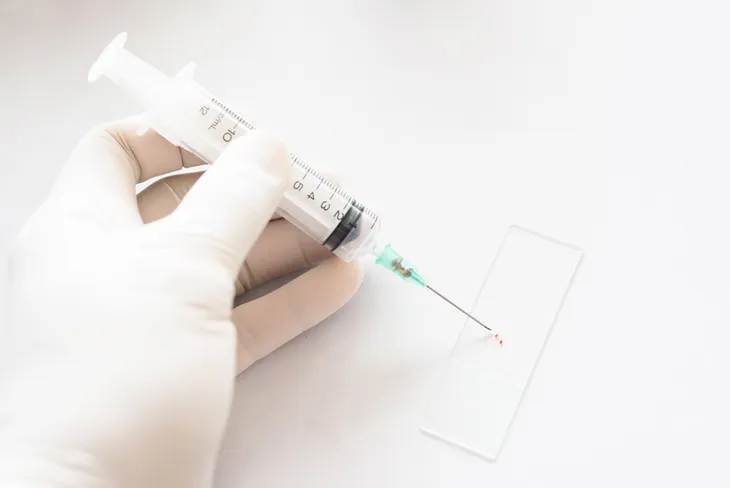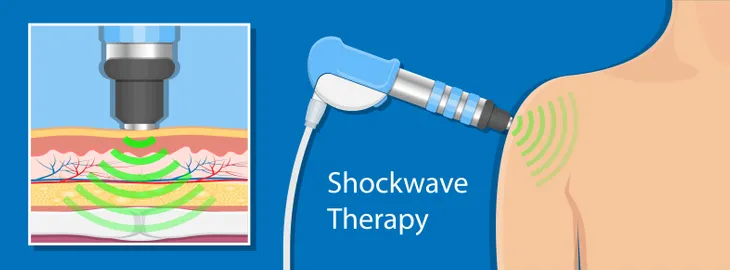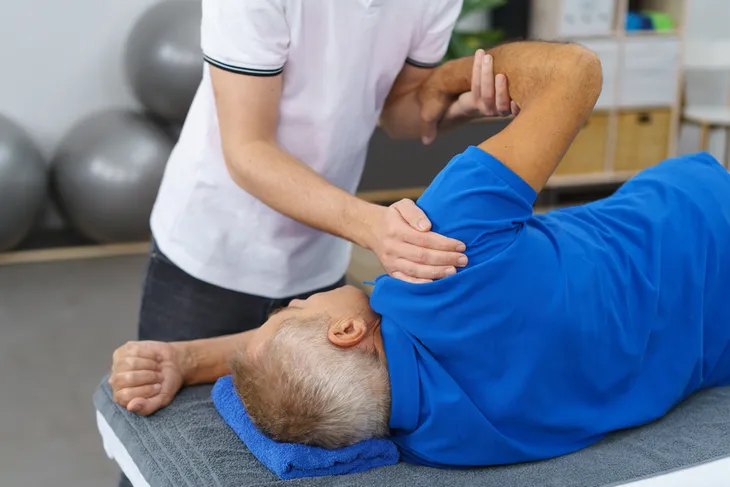Calcific tendonitis is a condition where calcium deposits build-up on the tendons or muscles. The deposits typically build-up on the rotator cuff which is what gives the shoulder its strength and stability, but calcific tendonitis can happen anywhere. Unlike many other joint conditions, calcific tendonitis isn’t associated with playing sports or other activities. It can happen to both professional tennis players and couch potatoes.
These deposits are one of the most common causes of shoulder pain says Healthline. So getting a speedy diagnosis and proper treatment will allow you to stop the pain and get back to your regularly scheduled activities. Read on to learn more about calcium tendonitis symptoms, causes, and treatments.
Symptoms
Pain and Stiffness
The prevalent symptom of calcific tendonitis is pain and stiffness in the affected area. As common as pain is, it turns out that one-third of people with calcific tendonitis will not have any symptoms of the condition. If you aren’t one of those lucky people, Healthline tells us “If you do feel pain, it’s likely to be in the front or back of your shoulder and into your arm. It may come on suddenly or build up gradually.”
Calcific tendonitis has three stages. The first stage, the pre-calcification stage, is when cellular changes occur within the body. The second stage, the calcific stage, is when “calcium releases from the cells and begins to build up…the body reabsorbs the calcium build-up, which is the most painful part of the process,” reports Medical News Today. The third stage, the post-calcific stage, is when the calcium deposits are gone and the tendons return to their healthy state.
Decreased Range of Motion
The calcium build-up can cause some people to lose their range of motion or make movement incredibly painful. Decreased range of motion means that the affected joint cannot move as freely as it once did. There are several reasons this can happen, including stiffness, joint dislocation, and injury. However, in the case of calcific tendonitis, it is typically due to pain.
But just because you have a decreased range of motion doesn’t mean you have calcific tendonitis. This is a symptom of several conditions including frozen shoulder and traditional (not calcific) tendonitis. It’ll be hard to know on your own what the specific cause is, so make sure to reach out to your doctor for further guidance.
Trouble Sleeping
With so much happening in our lives, it can be hard to sleep without having a painful shoulder condition. Add calcific tendonitis to the equation and sleep now becomes even more elusive. Calcific tendonitis makes it hard to sleep because of the pain and stiffness in the shoulder. Many people sleep on their sides, which can worsen symptoms and make sleep tough.
If you are having trouble sleeping, try changing your sleep position. Sleeping on your back is the best position for your shoulder health. Place a pillow under your legs to support your lower back. Even a small pillow under each arm can add additional support for your shoulders. If these remedies do not work, please reach out to your doctor.
Causes
Calcium Build-Up
The true cause of calcific tendonitis is a build-up of calcium on the tendons and surrounding muscles. WebMD says, “Calcium deposits feel like toothpaste. They can collect in one spot or spread out around the tendons.” While they most often happen in the shoulder, the Achilles tendon is another common place for it to occur. The pain comes on quickly and is often felt in the morning when you start moving around.
Doctors don’t know why some people develop calcific tendonitis and others don’t. It doesn’t seem to have a specific cause but there are definitely risk factors that can increase your chances of developing the condition. Here are the risk factors for calcific tendonitis as described by the medical journal Joints:
- Female gender
- Age 40 to 60 years
- Genetic predisposition to calcium deposits
- Diabetes
- Abnormal thyroid activity
- Tendon damage
Treatments
Medication
Shoulder pain and stiffness caused by calcific tendonitis are typically first treated with medication. Over-the-counter nonsteroidal anti-inflammatory drugs (NSAIDs), such as ibuprofen (Advil) and naproxen (Aleve) are two options that are generally well tolerated and have minimal side effects. Always check with your doctor or pharmacist before you start taking a new medication.
If these medications do not provide pain relief, there may be a prescription anti-inflammatory drug that your doctor can give you. These medications will lessen the symptoms of pain and swelling but won’t actually cure the condition.
Steroid Injection
Corticosteroids are powerful medications that can be injected directly into the affected area to provide pain relief. These medications will reduce inflammation within the area and reduce pain. This can allow people to do the necessary physical therapy and have a better/quicker return to a normal lifestyle.
While steroid injections are a great treatment, they are not a perfect fix. Some people will need multiple injections to find relief, and there is usually a limit on how many injections you can have. Talk to your doctor to determine if you are a good candidate for a steroid injection for calcific tendonitis.
Surgery
If conservative treatment fails to bring you pain relief, your doctor may suggest surgery. It’s important to know that the vast majority of people who have calcific tendonitis do not need surgery. It is the last resort for those who do not respond to other treatments. Arthroscopic surgery is the usual surgical technique used, although open surgery may be necessary. Arthroscopic surgery uses very small incisions to allow the surgeon to perform the procedure, while open surgery uses larger incisions.
According to VeryWell Health, “The usual approach is to attempt to remove some, if not all, of the calcium deposit, and clean up the inflammation surrounding the tendon.” The source continues to say “…some surgeons recommend removing some bone to create more space for the healing tendon, called subacromial decompression.” Your surgeon will discuss the risks and benefits of each procedure to help you determine the best route for your situation.
Needle Aspiration
This is a mildly invasive procedure that is sometimes called a lavage. The doctor will numb your skin with a local anesthetic or you might be given a medication for general sedation. WebMD says the procedure “involves inserting two needles into the tendon and rinsing the area with a saltwater solution. Lavage can break the calcium particles loose and ease pain.”
Another similar procedure is barbotage (or fine needling). According to the source, “in this procedure, your doctor uses needles to suck the calcium deposits out of the tendon.” There will be some soreness after these procedures but minimal downtime. Follow your doctor’s instructions on how to care for the procedural area.
Ultrasound Therapy
Ultrasound therapy can be used to break up the calcium deposit to alleviate the symptoms. This is an outpatient procedure that has no downtime and does not need to puncture the skin (unlike needling and surgery). The ultrasound device will use a high-frequency sound wave that is directed toward the affected area to break up the calcium deposit.
Ultrasound therapy is usually painless. If you have been diagnosed with calcific tendonitis ask your doctor if this treatment is available to you. With minimal pain and downtime, it makes a great treatment option.
Shockwave Therapy
There are two types of shockwave therapy that are used to treat calcific tendonitis. The first, extracorporeal shockwave therapy (ESWT) “involves a small handheld device that delivers mechanical shocks to a person’s shoulder, close to where the calcium deposits have built up” reports Healthline. The source says that this kind of shockwave therapy is done once a week for 3-weeks.
The other type of shockwave therapy is radial shockwave therapy (RSWT). According to Healthline, “This procedure is very similar to ESWT and involves a handheld device that will deliver low- to medium-energy shocks to the shoulder where the calcium has built up.” The source does mention that these shocks are more effective when the frequency is higher. But along with higher frequency can come more pain. Your doctor can adjust the frequency according to your comfort level.
Physical Therapy
Physical therapy for calcific tendonitis is aimed at restoring your range of motion, strength, and flexibility. When the initial pain has subsided and you are ready for movement reach out to a local physical therapist. They will perform an initial evaluation and then develop a plan for your therapy.
The therapy can range from stretching techniques to muscle building. The plan will be customized to your specific needs and you will be reevaluated periodically to assess your progress. Don’t be afraid to push yourself during physical therapy. But if you have significant pain, it’s time to stop and take a break.














